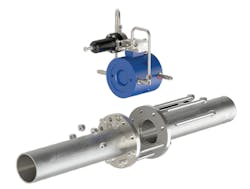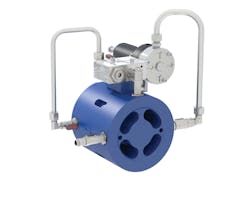Calming Water Networks with Next-Generation PRV Technology
By David Smith
There are an estimated 240,000 water mains breaks per year in the United States, wasting more than two trillion gallons of treated potable water. That’s nearly six billion gallons of water per day that could support 15 million households.
Globally, water distribution systems are currently using cast-iron bodied, diaphragm-style pressure reducing valves (PRV) that were designed a century ago. There are known performance limitations and regular maintenance is required with these types of valves. In particular, it is important for a PRV to work across a wide range of flow and pressure conditions without the effects of cavitation or performance degradation due to high head loss across the valve, as well as at low flows without the risk of instability.
Wafer-type installation between PN10/PN16 flanges minimizes installation footprint.
Born in the engineering test facilities of Oxford University, Oxford Flow’s water PRV design is, by contrast, light, reliable and corrosion-resistant. It performs consistently across a wide range of pressure and flow conditions. Additionally, it is capable of providing precise pressure control across a water distribution network using a lower upstream pressure and thereby further reducing system leakage. The simple three-piece design requires no regular maintenance with only one moving part and no diaphragm.
Utilities can now develop a smart water pipeline monitoring and control system around a PRV with proven performance across all flow and pressure conditions. Oxford Flow is at the forefront of developing the smart valve concept hardware that will dovetail seamlessly with a water company’s SCADA system.
Using data derived directly from the valve, we can provide real-time pressure and flow data as well as water quality monitoring, making it a truly intelligent system. By actuating the pilot control valve, we can adjust downstream pressure remotely through the control room SCADA system, enabling optimization of the wider network against multiple parameters.
The Oxford Flow’s pilot-controlled, wafer-type pressure reducing valves (PRVs) are developed specifically for water applications.
Understanding the dynamics of flow and pressure across the distribution network, the SCADA system can automatically adjust pressures to calm the network and proportionally reduce the level of leakage in the system. Should a leak or water quality issue occur, it will be visible to the SCADA system operators who can intervene remotely before a crew can be dispatched to address the issue.
Undoubtedly, investment in upgrading water distribution system integrity represents a cost to private water companies or municipal rate payers. However, the long-term effects of not taking action will be far worse. By introducing comprehensive pressure management into existing networks, utilities can effectively reduce leaks and avoid costly repairs from reacting to pipe bursts. This helps better manage OPEX and will help justify smart pipe solutions on future system expansions. WW
About the Author: David Smith is the North American business development director for Oxford Flow. Learn more at www.oxford-flow.com.
Circle No. 249 on Reader Service Card


